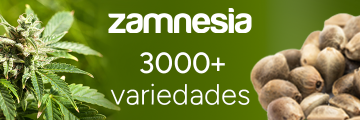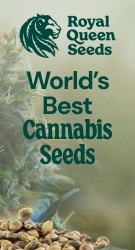Kazakhstan
producido de The Landrace Team
Aquí puede encontrar toda la información sobre Kazakhstan de The Landrace Team. Si busca información sobre Kazakhstan de The Landrace Team, consulte la Información Principal o Linaje / Genealogía sobre esta variedad de cannabis aquí en esta página y siga los enlaces para obtener aún más información - o enumere todas las Variedades de Kazakhstan (2) para encontrar una versión diferente. Si tienes alguna experiencia personal con el cultivo o el consumo de esta variedad de cannabis, ¡utiliza los enlaces de carga para subirlos a la base de datos!
Información del criador
Kazakhstan es una variedad de floración automática ruderalis de Landrace Team y se puede cultivar interiores, exteriores y en invernaderos, donde las plantas femeninas, autoflorecientes necesitan ±60 días desde la siembra hasta la cosecha. Semillas de Kazakhstan de Landrace Team es dominante en THC y no están disponibles en versiones feminizadas.
Descripción de Landrace Team Kazakhstan

 Genetics: Pure Kazakh landrace Autoflower
Genetics: Pure Kazakh landrace Autoflower
Sourcing: Sourced by Russian Landrace Bureau
Latitude: 42°N
Altitude: 649 m.a.s.l
Height: 1.5 – 3 metres
Aroma: Very strong pungent sweet odor, pleasant fruity hints of melon.
Harvest: Late August – beginning of September
Height: 1.5 – 3 metres
Resin: Moderate
Effects: Euphoria, mildly intoxicating, medicinal
Purposes: Multi-purpose cultivar, with a long local history of use for medicinal purposes, including smoking.
Growtype: Outdoor, indoor, greenhouse
Kazakhstan does not grow too fast a few days after germination, the plant is building an extensive and deep root system. Growth intensifies after a few days and is followed by leap growth and the development of massive leaves with narrow leaflets. Each plant shows a different growth strategy, some plants form long twigs perpendicular to the stem and richly branched in the ground, in some plants growth significantly predominates in height.
Plants require a lot of space for roots, then the growth is very intense. The plants switch to flowering very easily and quickly, just a slight change in the photoperiod is enough. Plants can be reveged if on time, during indoor cultivation, switched to 24/0 on time.
Flowering time is 7-9 weeks. After transitioning to the flower, the females do not stop growing and the buds stretch and form long thin twigs, the buds gradually thicken and form a large number of new pistils throughout the rippening of the main buds. From the twelve seeds, we had five males and seven females. Three red stemmed males and two green stemmed Green males showed faster growth and later higher pollen production.
Two females showed pink pistils. Six females had a relatively similar bud structure, buds bushy on long thin branches which in two cases even broke. One female had extremely rare buds and significantly more compared to the others stretching. Its aroma is, unlike others, slightly more sweet fruity, but it does not affect the taste of the smoke. The smell of buds is slightly sour to pungent with a sweet undertone, some phenotypes more fruity, some with faint hash and diesel hints. The smoke is very soft and sweet, the effect is slightly high, soothing.
Suitable for outdoor and greenhouse growing, but it is possible to grow this variety in an indoor setting. It is advisable to be very selective when growing indoor, we have not found any hermaphrodite traits growing outdoors but we have found a percentage of hermaphrodite when adapting to indoor use. Our collection comes from the southern side of Karatau Mountains outside of Lugovoy, Jambyl Kazakhstan.
Located in southern Kazakhstan, near the region borders Kyrgyzstan, and is very near to Uzbekistan (all to the south). Jambyl also borders three other provinces: Karaganda Region (to the north), Turkistan (to the west) and Almaty Region (to the east).
Description
The majority of plants had a narrow leaf dominant structure. They were enormous plants with many side branches and big colas. The stock was thick and the buds were not extremely airy but showed some capacity for density.
Seeds
It is advisable to first give these seeds a peroxide wash in light solution mix, and than manually crack the seeds. And after, either Soak the seeds in a solo cup of dechlorinated water containing aloe Vera for 24-36 hours or transferring them to a wet tissue tech after manually cracking them. Keep in 75f degree environment day and night in a dark place and you should have 70% germination rate.
*These seeds are dark and fairly small with a hard shell.
*Noteworthy – will ripen around August 10th. Extremely short flowering, crossing this variety with a longer flowing variety will predictably cause the resulting hybrid to flower earlier.
Topography
Karatau mountain range is the north-western spur of the Western Tien-Shan in southern Kazakhstan. It extends from the Talas Ala Tau and gradually decreases, goes into Syrasu-Chui plain. The length of the ridge Karatau is 420 kilometers.
It is divided into East or Small Karatau and Southwest Karatau. The highest point of the Karatau ridge is the Bessaz mountain, 2176 meters above sea level. East Karatau has a slightly undulating, apical surface composed of shale and Proterozoic sandstones.
The southwestern Karatau is cut by numerous valleys and is divided into a series of massifs composed of limestone, sandstone, carboniferous conglomerates and the Devonian volcanogenic rocks. To the northwest, the mountain passes to the plateau already at the confluence of the dry channels of the Sarysu and Chu rivers. The valleys located between two ridges are composed of red clay. Mezozoic and Cenozoic deposits of limestone, sandstone, and clay are also widespread. The local relief was formed in conditions of a dry climate. There is no permanent surface runoff.The slopes are dissected by large and small canyons and dry river beds. Vertices are flat, aligned. The valley of the Syr-Darya River flows away from the Karatau Range to the south-west, and the valley of the Talas River to the northeast.
The Karatau Mountains have a great influence on the weather conditions of the territories of the nearby regions. The average January temperature is 10 degrees C. The difference between the average January temperatures on the northeastern and southwestern slopes of Karatau is between 4 and 6 degrees C, which is explained by the influence of warm air masses from the southwestern slopes.
The average annual amount of precipitation at the foot of the slopes of 200 – 400 mm, above 400 – 600 mm.
The prevailing landscape is desert-steppe. In the spring wild, tulips, irises and poppies bloom brightly covering the horizon as far as the eye can see. The slopes of the mountains are used for grazing livestock (mainly sheep and goats).
No hay descripción adecuada español hasta ahora!
Kazakhstan Linaje / Genealogía
- Kazakhstan »»» Kazakh Landrace
- Kazakh Landrace »»» Ruderalis
Árbol Genealógico de Kazakhstan
Subir su info acerca de esta variedad aquí:
¿Sabes algo más sobre Kazakhstan de Landrace Team? ¡Ayude a mejorar esta base de datos y cargue / conecte su información aquí!
Fotos
Imágenes que son más elocuentes que las palabras! Kazakhstan Sube tus Fotos para ayudar a los cultivadores a obtener una mejor impresión de esta variedad.
Comparaciones
Ha cultivado Kazakhstan junto con otra variedad? Por favor agregue una comparacion directa aqui.
Recensiónes
Nuestras revisiones son multilingues y pueden ser muy detalladas, incluyendo datos sobre el crecimiento, aroma, efectos y sabor! Por favor, Kazakhstansuba su resena de aqui para ayudar a los otros usuarios de seedfinder!
Valores Medicinales
Usted tiene experiencia con la calidad médica de Kazakhstan? Compartir su información aqui puede ayudar a otras personas!
Temas
Se ha topado con un tema relacionado de Kazakhstan en una comunidad en linea? Conecte el tema aqui para permitir que otros usuarios encuentren esta informacion rapida y facilmente!
Videos
Encontro un video relacionado con info adicional o de crecimiento sobre Kazakhstan en YouTube? Conectelo aqui para ayudar a otros a encontrarlo facilmente!


